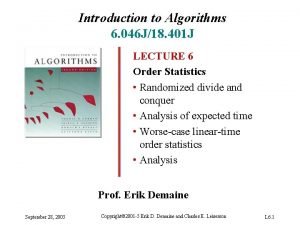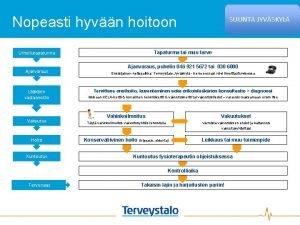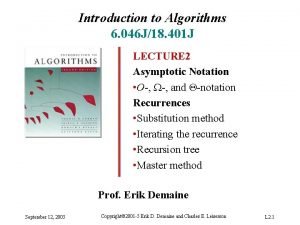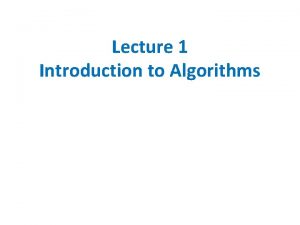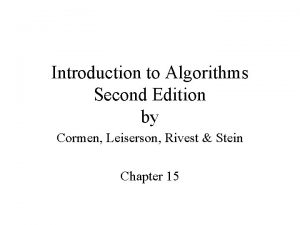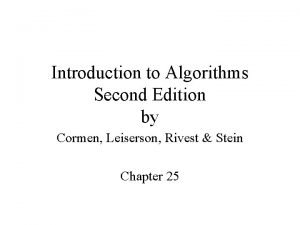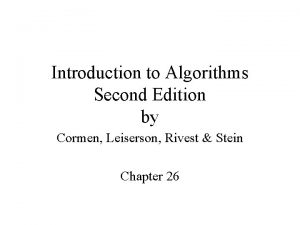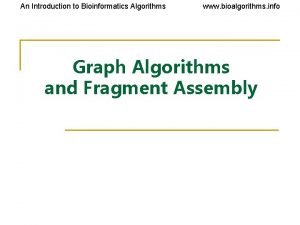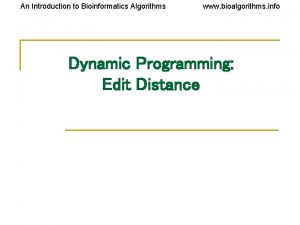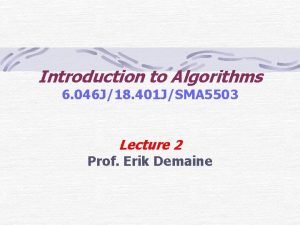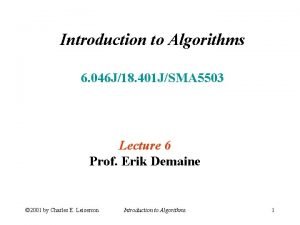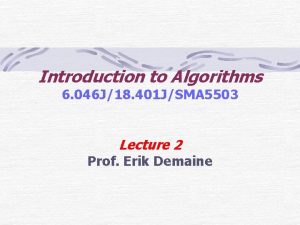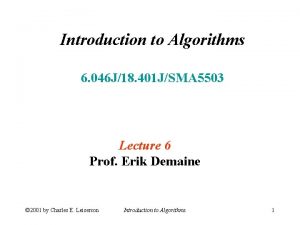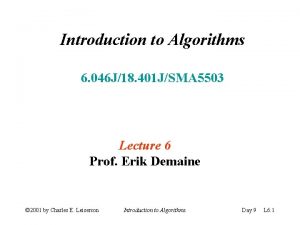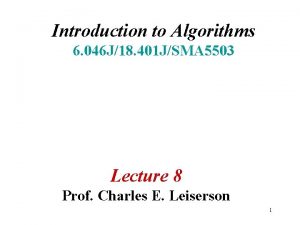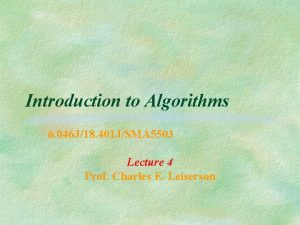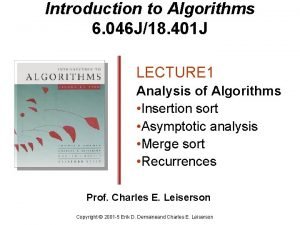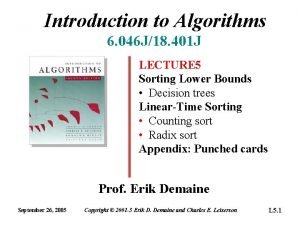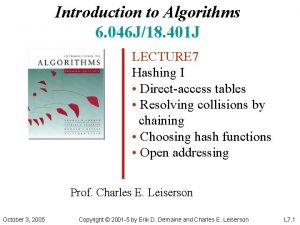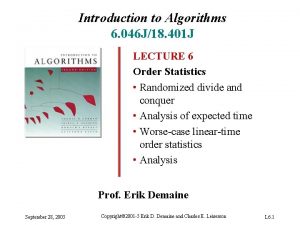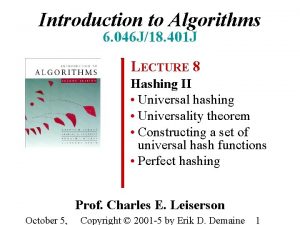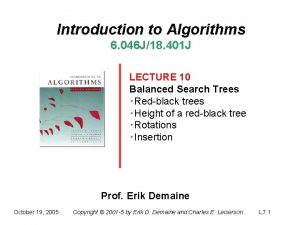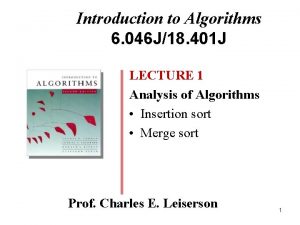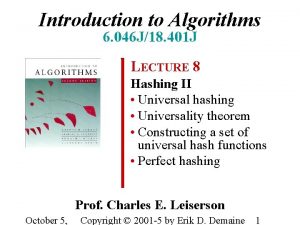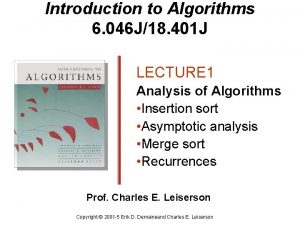Introduction to Algorithms 6 046 J18 401 JSMA


![Bellman-Ford algorithm d[s] ← 0 for each v V – {s} initialization do d[v] Bellman-Ford algorithm d[s] ← 0 for each v V – {s} initialization do d[v]](https://slidetodoc.com/presentation_image_h2/74faf413b8450733fb9ef4100dac8535/image-3.jpg)










![Correctness (continued) Initially, d[v 0] = 0 = (s, v 0), and d[s] is Correctness (continued) Initially, d[v 0] = 0 = (s, v 0), and d[s] is](https://slidetodoc.com/presentation_image_h2/74faf413b8450733fb9ef4100dac8535/image-14.jpg)
![Detection of negative-weight cycles Corollary. If a value d[v] fails to converge after |V| Detection of negative-weight cycles Corollary. If a value d[v] fails to converge after |V|](https://slidetodoc.com/presentation_image_h2/74faf413b8450733fb9ef4100dac8535/image-15.jpg)










- Slides: 25

Introduction to Algorithms 6. 046 J/18. 401 J/SMA 5503 Lecture 18 Prof. Erik Demaine 1

Negative-weight cycles Recall: If a graph G = (V, E) contains a negativeweight cycle, then some shortest paths may not exist. Bellman-Ford algorithm: Finds all shortest-path lengths from a source s V to all v V or determines that a negative-weight cycle exists. © 2001 by Charles E. Leiserson 31 L 18. Introduction to Algorithms Day 2
![BellmanFord algorithm ds 0 for each v V s initialization do dv Bellman-Ford algorithm d[s] ← 0 for each v V – {s} initialization do d[v]](https://slidetodoc.com/presentation_image_h2/74faf413b8450733fb9ef4100dac8535/image-3.jpg)
Bellman-Ford algorithm d[s] ← 0 for each v V – {s} initialization do d[v] ← for i ← 1 to |V| – 1 do for each edge (u, v) E do if d[v] > d[u] + w(u, v) relaxation then d[v] ← d[u] + w(u, v) step for each edge (u, v) E do if d[v] > d[u] + w(u, v) then report that a negative-weight cycle exists At the end, d[v] = (s, v). Time = O(VE) © 2001 by Charles E. Leiserson 31 L 18. Introduction to Algorithms Day 3

Example of Bellman-Ford © 2001 by Charles E. Leiserson 31 L 18. Introduction to Algorithms Day 4

Example of Bellman-Ford © 2001 by Charles E. Leiserson 31 L 18. Introduction to Algorithms Day 5

Example of Bellman-Ford © 2001 by Charles E. Leiserson 31 L 18. Introduction to Algorithms Day 6

Example of Bellman-Ford © 2001 by Charles E. Leiserson 31 L 18. Introduction to Algorithms Day 7

Example of Bellman-Ford © 2001 by Charles E. Leiserson 31 L 18. Introduction to Algorithms Day 8

Example of Bellman-Ford © 2001 by Charles E. Leiserson 31 L 18. Introduction to Algorithms Day 9

Example of Bellman-Ford © 2001 by Charles E. Leiserson 31 L 18. Introduction to Algorithms Day 10

Example of Bellman-Ford © 2001 by Charles E. Leiserson 31 L 18. Introduction to Algorithms Day 11

Example of Bellman-Ford Note: Values decrease monotonically. © 2001 by Charles E. Leiserson 31 L 18. Introduction to Algorithms Day 12

Correctness Theorem. If G = (V, E) contains no negativeweight cycles, then after the Bellman-Ford algorithm executes, d[v] = (s, v) for all v V. Proof. Let v V be any vertex, and consider a shortest path p from s to v with the minimum number of edges. Since p is a shortest path, we have (s, vi) = (s, vi-1) + w(vi-1 , vi). © 2001 by Charles E. Leiserson 31 L 18. Introduction to Algorithms Day 13
![Correctness continued Initially dv 0 0 s v 0 and ds is Correctness (continued) Initially, d[v 0] = 0 = (s, v 0), and d[s] is](https://slidetodoc.com/presentation_image_h2/74faf413b8450733fb9ef4100dac8535/image-14.jpg)
Correctness (continued) Initially, d[v 0] = 0 = (s, v 0), and d[s] is unchanged by subsequent relaxations (because of the lemma from Lecture 17 that d[v] ≥ (s, v)). • After 1 pass through E, we have d[v 1] = (s, v 1). • After 2 passes through E, we have d[v 2] = (s, v 2). • After k passes through E, we have d[vk] = (s, vk). Since G contains no negative-weight cycles, p is simple. Longest simple path has ≤|V| – 1 edges. © 2001 by Charles E. Leiserson 31 L 18. Introduction to Algorithms Day 14
![Detection of negativeweight cycles Corollary If a value dv fails to converge after V Detection of negative-weight cycles Corollary. If a value d[v] fails to converge after |V|](https://slidetodoc.com/presentation_image_h2/74faf413b8450733fb9ef4100dac8535/image-15.jpg)
Detection of negative-weight cycles Corollary. If a value d[v] fails to converge after |V| – 1 passes, there exists a negative-weight cycle in G reachable from s. © 2001 by Charles E. Leiserson 31 L 18. Introduction to Algorithms Day 15

DAG shortest paths If the graph is a directed acyclic graph (DAG), we first topologically sort the vertices. • Determine f : V → {1, 2, …, |V|} such that (u, v) E f (u) < f (v). • O(V + E) time using depth-first search. Walk through the vertices u V in this order, relaxing the edges in Adj[u], thereby obtaining the shortest paths from s in a total of O(V + E) time. © 2001 by Charles E. Leiserson 31 L 18. Introduction to Algorithms Day 16

Linear programming Let A be an m× n matrix, b be an m-vector, and c be an n-vector. Find an n-vector x that maximizes c. Tx subject to Ax ≤ b, or determine that no such solution exists. © 2001 by Charles E. Leiserson 31 L 18. Introduction to Algorithms Day 17

Linear-programming algorithms Algorithms for the general problem • Simplex methods — practical, but worst-case exponential time. • Ellipsoid algorithm — polynomial time, but slow in practice. • Interior-point methods — polynomial time and competes with simplex. Feasibility problem: No optimization criterion. Just find x such that Ax ≤ b. • In general, just as hard as ordinary LP. © 2001 by Charles E. Leiserson 31 L 18. Introduction to Algorithms Day 18

Solving a system of difference constraints Linear programming where each row of A contains exactly one 1, one – 1, and the rest 0’s. Example: Solution: x 1 – x 2 ≤ 3 x 2 – x 3 ≤ – 2 x 1 – x 3 ≤ 2 xj – xi ≤ wij Constraint graph: xj – xi ≤ wij © 2001 by Charles E. Leiserson 31 L 18. Introduction to Algorithms x 1 = 3 x 2 = 0 x 3 = 2 (The “A” matrix has dimensions |E| × |V|. ) Day 19

Unsatisfiable constraints Theorem. If the constraint graph contains a negative-weight cycle, then the system of differences is unsatisfiable. Proof. Suppose that the negative-weight cycle is v 1 → v 2 → → vk → v 1. Then, we have x 2 – x 1 ≤ w 12 x 3 – x 2 ≤ w 23 Therefore, no values for the xi xk – xk-1 ≤ wk– 1, k can satisfy the x 1 – xk ≤ wk 1 constraints. 0 ≤ weight of cycle <0 © 2001 by Charles E. Leiserson 31 L 18. Introduction to Algorithms Day 20

Satisfying the constraints Theorem. Suppose no negative-weight cycle exists in the constraint graph. Then, the constraints are satisfiable. Proof. Add a new vertex s to V with a 0 -weight edge to each vertex vi V. Note: No negative-weight cycles introduced shortest paths exist. © 2001 by Charles E. Leiserson 31 L 18. Introduction to Algorithms Day 21

Proof (continued) Claim: The assignment xi = (s, vi) solves the constraints. Consider any constraint xj – xi ≤ wij, and consider the shortest paths from s to vj and vi: The triangle inequality gives us (s, vj) ≤ (s, vi) + wij. Since xi = (s, vi) and xj = (s, vj), the constraint xj – xi ≤ wij is satisfied. © 2001 by Charles E. Leiserson 31 L 18. Introduction to Algorithms Day 22

Bellman-Ford and linear programming Corollary. The Bellman-Ford algorithm can solve a system of m difference constraints on n variables in O(mn) time. Single-source shortest paths is a simple LP problem. In fact, Bellman-Ford maximizes x 1 + x 2…+ + xn subject to the constraints xj – xi ≤ wij and xi ≤ 0 (exercise). Bellman-Ford also minimizes maxi{xi} – mini{xi} (exercise). © 2001 by Charles E. Leiserson 31 L 18. Introduction to Algorithms Day 23

Application to VLSI layout compaction Integrated -circuit features: minimum separation λ Problem: Compact (in one dimension) the space between the features of a VLSI layout without bringing any features too close together. © 2001 by Charles E. Leiserson 31 L 18. Introduction to Algorithms Day 24

VLSI layout compaction Constraint: x 2 – x 1 ≥ d 1 + λ Bellman-Ford minimizes maxi{xi} – mini{xi}, which compacts the layout in the x-dimension. © 2001 by Charles E. Leiserson 31 L 18. Introduction to Algorithms Day 25
 S/2005 j18
S/2005 j18 Suunta jyväskylä
Suunta jyväskylä Gallyazás szabályai
Gallyazás szabályai Algorithm analysis examples
Algorithm analysis examples Bioalgorithms
Bioalgorithms Design and analysis of algorithms introduction
Design and analysis of algorithms introduction Introduction to algorithms
Introduction to algorithms Introduction to algorithms 강의
Introduction to algorithms 강의 Introduction to algorithms 2nd edition
Introduction to algorithms 2nd edition Introduction to algorithms
Introduction to algorithms Introduction to algorithms lecture notes
Introduction to algorithms lecture notes Introduction to the design and analysis of algorithms
Introduction to the design and analysis of algorithms Introduction to sorting algorithms
Introduction to sorting algorithms Introduction to algorithms 2nd edition
Introduction to algorithms 2nd edition Introduction to algorithms 2nd edition
Introduction to algorithms 2nd edition Introduction to bioinformatics algorithms
Introduction to bioinformatics algorithms Bioalgorithms
Bioalgorithms Lsp 401
Lsp 401 Svartpilen 401 dyno
Svartpilen 401 dyno Cse 401
Cse 401 Ge 401
Ge 401 Where should charts with food code 3-401 be displayed
Where should charts with food code 3-401 be displayed Eng m 401
Eng m 401 Clase 401
Clase 401 401 branard st
401 branard st Bmb 401 umiami
Bmb 401 umiami
